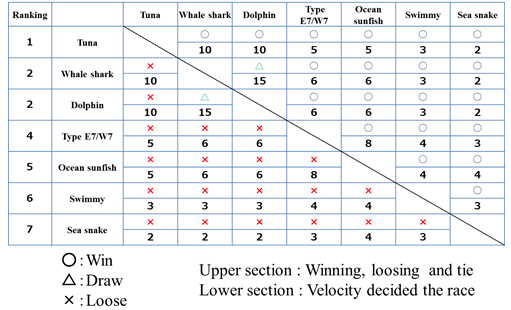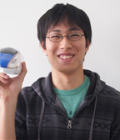Newsletter 2015.2 Index
Theme : "The Conference of Fluid Engineering Division"
|
The Dream Aquarium
Daichi SAITO Tomonari SATO |
Abstract
We participated JSME 13th Dreams of Flow Contest held at Toyama University as Team Dream Aquarium. In this report, we summary our articles and demonstrations.
Dream Aquarium is the name of our articles and demonstrations. It consists of four-link mechanisms (Fig. 1) and small scale models of aquatic animals shaped by ourselves (Fig. 2). With using these items, we can easily compare the magnitude of drug on aquatic animals. The model has shape for lower flow drag moves forward by blowing the uniform air flow for two models mounted on the four-link mechanisms.

Fig. 1 A photo of four-link mechanisms

Fig. 2 Pictures of aquatic animal models
Generally, the drag F acting on the object in steady, uniform flows is formulized
 |
(1) |
where ρ is the density of the fluid, U is the main stream velocity, S and CD are the projected area and the drag coefficient of the object. As it is clear from Eq. (1), S makes not a few contributions to F. This means aquatic animals whose body size are large such as whale shark and dolphin are at a disadvantage when we standardize the scale of length of the models and compare the drug. This is not suitable for your articles, and thus we decided to standardize S of all models to remove the effect of the body size. Now ρ, U, and S are constant and F is in proportion to CD. Therefore the comparison of F by four-link mechanisms becomes equivalent to the comparison of CD of each model. It becomes not so easy and interesting to estimate the correct ranking of drug, just like a horse race. We named this competition “fish race.”
Results of the fish race are summarized in the Table 1. We also visualized the flow fields around models by the method of smoke wire and took pictures (Fig. 3) to know what determines decision on the race.
Table 1 The result of “fish race”


Fig. 3 Visualization of flow field around models
Key words
aquatic animal, drug, visualization



